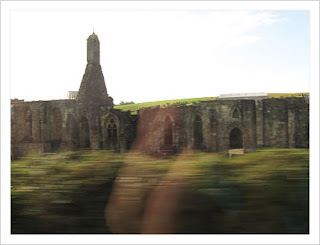 Washington Ballet's Dracula
Washington Ballet's Dracula
You missed it at the Kennedy Center: the premiere by the Washington Ballet of Michael Pink's dance adaptation of Bram Stoker's Dracula, originally published in 1897 and set to the dance stage 100 years later in England. (This just in from Google: Happy 165th birthday today, Mr. Stoker!)
Altogether, a captivating, thoroughly entertaining night with intrigue and more plot than found in most ballets, but not to overlook the dancing.
Immense leaps by "Dracula" (Hyun-Woong Kim) and his partners were exciting, devouring the entire stage, especially a lengthy but effective and muscular duet with "Jonathan Harker" (Jared Nelson who was the monster in half the performances).
Yes, when four or more were gathered en l'air a pirouette, the synchronization of their leaps was not the Mariinsky, but what not to enjoy? The corps de ballet matched expectations.
The sets changed as quickly as Dracula was able to sink his teeth in his next victim, melding magically from one into another, and we're not talking about minor sets. They consumed the whole stage, left, right, and ceiling.
Main characters disappeared in smoke and caskets. The lighting by Paul Pyant was excellent and effective. In one of the most memorable scenes, grey and black gates about 20 feet tall and lighted from above, stood on the darkened stage, creating a haunting entrance to greet Harker until, until the silhouette of a frightening castle on a high hill gradually came into focus. Shades of Psycho.
The heroines were practically always dressed in whiteness, natch, and many of the scenes were all black and white, save the Count when he flew through the air in a magnificent red cape, neck to floor with a wingspan of about 30 feet, reminiscent of a pteranodon (however, they had no teeth).
Even in the ballroom the dancers wore muted tones, except for the red lanterns (red lanterns?) and the red coats of the military, mostly reserving the sharp contrast (red) for Count Evil.
The only missing element: flying batterinas.
Before the show started, Washington Ballet's artistic director, Septime Webre, came out on stage to provide brief background for the audience, noting late 19th century English crowds flocked to macabre and mysterious shows. A romantic ballet, Dracula is not, but suggestive of some romances? Alas.
Before the show started, Washington Ballet's artistic director, Septime Webre, came out on stage to provide brief background for the audience, noting late 19th century English crowds flocked to macabre and mysterious shows. A romantic ballet, Dracula is not, but suggestive of some romances? Alas.
It was advised that Dracula may be too intense for young children, what with the gore and blood sucking and a ballerina's red-splattered neckline, but none of the young ballerinas spied in the audience seemed to show the least bit of fright. At least, it wasn't close to my bedtime.
At the program's end (three acts), the Count emerged like a stealth snake, slinking up and down from stage left to wild applause and standing balletomanes.
A good test about the quality of a production: Do you want to see it again?
Yes! Tomorrow, please.
And when does the Count meet the Phantom? Please sign me up for that dark and stormy night.Yes! Tomorrow, please.
Next:
The Nutcracker, November 24-25 and November 29 - December 23, 2012
patricialesli@gmail.com















.jpg)
.jpg)
.jpg)
.jpg)
.jpg)
.jpg)
.jpg)


.jpg)
.jpg)
.jpg) Skellig Michael/
Skellig Michael/






